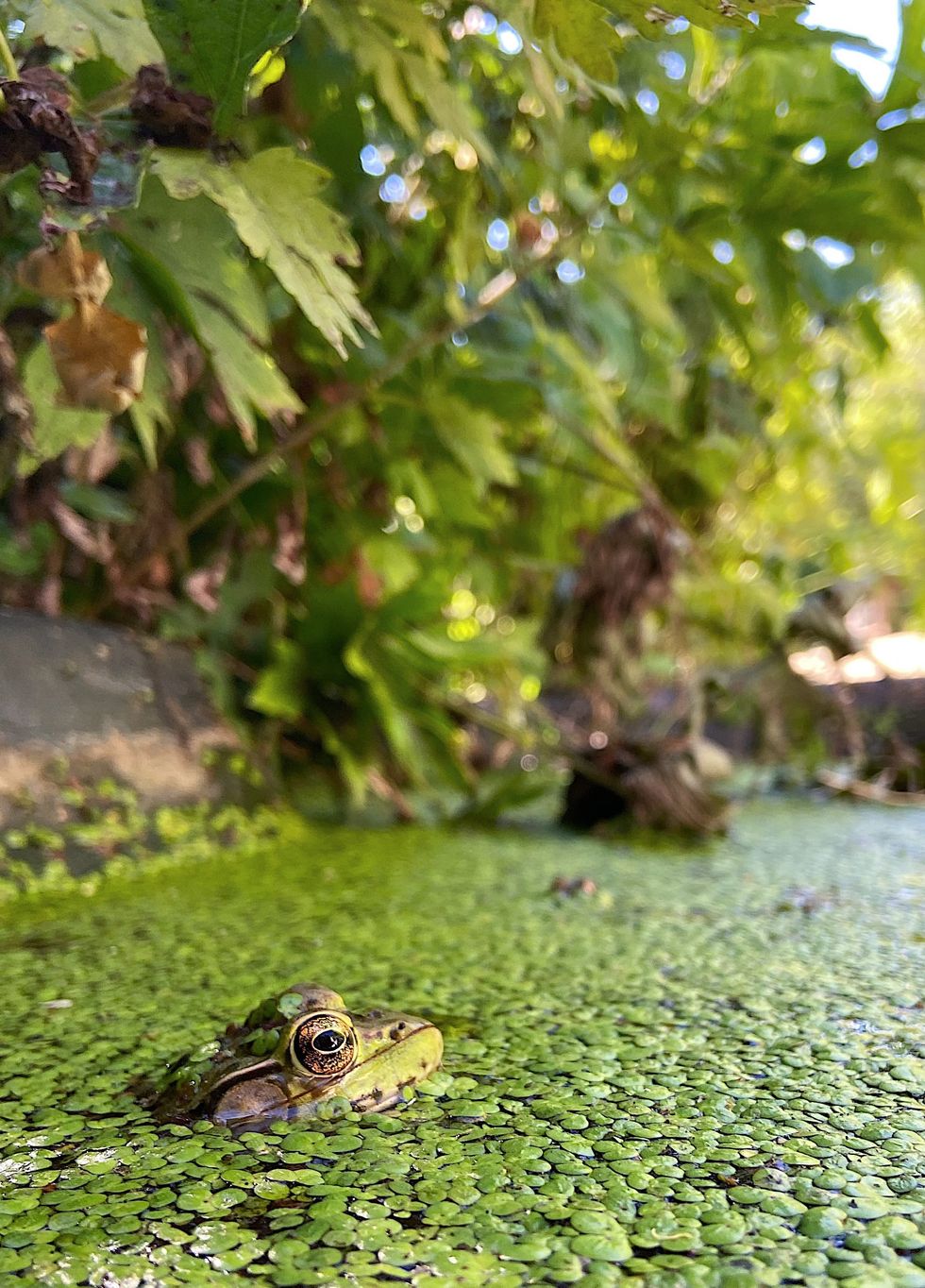Surviving intensifying heat waves

Green frogs hide from the sun under duckweed in a frog pond at the Sharon Audubon Center.
Photo by Alison Robey

When I tell people that I study ecological modeling for a living, the typical response is a wide-eyed stare and some variation of the question, “What on earth is that?”
Assuming most people don’t want to hear about differential equations and population dynamics, I’ve developed an abbreviated response: “Math about plants.”
“Math about plants” is a bit of an oversimplification — I also do math about animals —but it’s an accurate enough description of the research I do as a graduate student in ecology.
My daily work revolves around using equations to understand what is happening in the natural world and why. The questions we ask with those equations are key to the management and use of the environment around us; they range from predicting outbreaks of invasive insects (like the spongy moth) or infectious diseases (like COVID-19), to determining how much carbon is stored in a tree or how many black bears live in Connecticut.
Ecological modeling covers all that and more, but a childhood of canoeing on the Housatonic River and exploring the stonewall-studded forests of Kent has provided my specific equations with a clear central goal: figuring out how to best support these natural places as they face the novel challenges of a changing world.
Right now, we are all recovering from one of those challenges: heat waves.
Long stretches of unusually warm weather can be very disruptive to wildlife. Heat-induced worries for our songbirds and garden toads have real urgency, because while most humans are focused on issues of comfort, like sweaty skin or body odor, these creatures face a real risk of dying.
Most species have spent thousands of years carefully adapting to the very specific temperature ranges in which they usually live. When their internal temperature increases too far above the range they’ve adapted to, their cells become less efficient and more error-prone — problems that are exacerbated by other stressors, like water scarcity, as caused by this summer’s persistent drought.
Luckily, most species have a few tools to deal with uncomfortable heat. Some simply change their behavior, reducing their temperatures by hunting at dusk instead of midday or moving into “temperature refuges” of shady forest canopies and cooling bird baths. Those that cannot capitalize on such refuges rely on much smaller helpers: proteins.
The tiny proteins found in every living organism are both the problem and the solution of overheating. At the microscopic level, our cells build new proteins all the time. However, as cells heat up, they get much worse at making proteins that are the right shape. Misshapen proteins cannot perform their vital functions of building, regulating, and maintaining our anatomy — meaning that, left unchecked, flawed proteins eventually render their cells useless and their overheated organism dead.
Given the prevalence of this problem, cells experiencing heat stress evolved a defense. They produce a new kind of proteins — called “heat shock proteins” — that specialize in fixing or removing the misshapen proteins before they make a mess.
Here’s where the math comes back in. A key goal of climate scientists is predicting how changing conditions on our planet will affect future temperature patterns. For many places around the world, including our corner of Connecticut, those predictions indicate more intense and frequent heat waves in our future.
If we want to know how those predicted heat waves will impact the ecosystems that experience them, then we must know how likely that ecosystem’s organisms are to survive the higher temperatures. To make this prediction, we need to know how high temperatures can get — and how long they can stay there — before heat shock proteins are no longer a match for the heat’s devastating impact on an organism’s cells.
Better foresight about how future temperatures will impact different species helps us make informed decisions about which species to plant while restoring natural areas or as street trees. It also tells us when and where creating and maintaining temperature refuges, like cooling forest canopies or shady ponds, will be most important for protecting plants and animals from the hottest weather.
So as heat waves roll through, provide some shade and water in your greenspaces; your local wildlife appreciates it!
Alison Robey is a volunteer at the Sharon Audubon Center and a second-year PhD student in Ecology and Evolutionary Biology at Yale University.
The Stone Round Barn at Hancock Shaker Village.
My husband Tom, our friend Jim Jasper and I spent the day at Hancock Shaker Village in Pittsfield, Massachusetts. A cold, blustery wind shook the limbs of an ancient apple tree still clinging to golden fruit. Spitting sleet drove us inside for warmth, and the lusty smells of manure from the goats, sheep, pigs and chickens in the Stone Round Barn filled our senses. We traveled back in time down sparse hallways lined with endless peg racks. The winter light was slightly crooked through the panes of old glass. The quiet life of the Shakers is preserved simply.

Originally founded in England, the Shakers brought their communal religious society to the New World 250 years ago. They sought the perfection of heaven on earth through their values of equality and pacifism. They followed strict protocols of behavior and belief. They were celibate and never married, yet they loved singing and ecstatic dancing, or “shaking,” and often adopted orphans. To achieve their millennialist goal of transcendental rapture, we learned, even their bedclothes had to conform: One must sleep in a bed painted deep green with blue and white coverings.
Shakers believed in gender and racial equality and anointed their visionary founding leader, Mother Ann Lee, an illiterate yet wise woman, as the Second Coming. They embraced sustainability and created practical designs of great utility and beauty, such as the mail-order seed packet, the wood stove, the circular saw, the metal pen, the flat broom and wooden clothespins.
Burning coal smelled acrid as the blacksmith fired up his stove to heat the metal rod he was transforming into a hook. Hammer on anvil is an ancient sound. My husband has blacksmithing skills and once made the strap hinges and thumb latches for a friend’s home.
Shaker chairs and rockers are still made today in the woodworker’s shop. They are well made and functional, with woven cloth or rush seats. In the communal living space, or Brick Dwelling, chairs hang from the Shaker pegs that run the length of the hallways, which once housed more than 100 Shakers.

In 1826, the 95-foot Round Stone Barn was built of limestone quarried from the land of the 3,000-acre Hancock Shaker Village. Its unique design allowed a continuous workflow. Fifty cows could stand in a circle facing one another and be fed more easily. Manure could be shoveled into a pit below and removed by wagon and there was more light and better ventilation.
Shakers called us the “people of the world” and referred to their farm as the City of Peace. We take lessons away with us, yearning somehow for their simplicity and close relationship to nature. One Shaker said, “There’s as much reverence in pulling an onion as there is in singing hallelujah.”
A sense of calm came over me as I looked across the fields to the hills in the distance. A woman like me once stood between these long rows of herbs — summer savory, sage, sweet marjoram and thyme — leaned on her shovel brushing her hair back from her eyes, watching gray snow clouds roll down the Berkshires.
More information at hancockshakervillage.org

Exterior of Lakeville Books & Stationery in Great Barrington.
Fresh off the successful opening of Lakeville Books & Stationery in April 2025, Lakeville residents Darryl and Anne Peck have expanded their business by opening their second store in the former Bookloft space at 63 State St. (Route 7) in Great Barrington.
“We have been part of the community since 1990,” said Darryl Peck. “The addition of Great Barrington, a town I have been visiting since I was a kid, is special. And obviously we are thrilled to ensure that Great Barrington once again has a new bookstore.”
The second Lakeville Books & Stationery is slightly larger than the first store. It offers more than 10,000 books and follows the same model: a general-interest store with a curated mix of current bestsellers, children’s and young readers’ sections; and robust collections for adults ranging from arts and architecture, cooking and gardening, and home design to literature and memoirs. Anne reads more than 150 new titles every year (as many as a Booker Prize judge) and is a great resource to help customers find the perfect pick.
A real-time inventory system helps the store track what’s on hand, and staff can order items that aren’t currently available. There is also a selection of writing and paper goods, including notecards, journals, pens and notebooks, as well as art supplies, board games, jigsaw puzzles and more. The owners scour the stationery trade shows twice a year and, Darryl says, “like to tailor what we offer to suit the interest of our customers in each market.”
The Pecks know what it takes to run a successful local enterprise. Darryl has a 53-year background in retail and has launched several successful businesses. He and Anne owned and operated a bookstore on St. Simons Island, Georgia, from 2019 to 2025. They are tapping into their local roots with both stores. They raised their family in Sharon, and their daughter Alice, a native of the Northwest Corner, manages the Lakeville store.

The family values the role that a retail store plays as a supporting partner in the community, and they prioritize great management in both locations, hiring and training talent from local communities. Their 10 team members across both stores are from the area, and two of the Great Barrington employees previously worked at Bookloft.
Darryl and Anne’s attention to customer service is everywhere apparent and adds to the enjoyable and irreplaceable in-store shopping experience. The books are in pristine condition, eliminating the risk of damage that sometimes occurs during shipping. This is especially important for books that will live on people’s shelves and coffee tables for years.
Darryl says, “People love the in-store discovery — you find books you didn’t know existed, which is very difficult to do on a website. Also, many customers depend on our recommendations when visiting. There is a saying about bookstores versus online ordering: We may not have exactly what you were looking for, but we have what you want.”
Lakeville Books & Stationery’s Great Barrington store is open 7 days a week, Monday-Saturday, 10 a.m. to 6 p.m., and Sunday, 11 a.m. to 5 p.m. Parking is available in the lot behind the building and in the parking lot behind the firehouse. The entrance to the store is accessible from the store parking lot.
For more information, go to lakevillebooks.com., and sign-up for the Lakeville Books newsletter.
Richard Feiner and Annette Stover have worked and taught in the arts, communications, and philanthropy in Berlin, Paris, Tokyo and New York. Passionate supporters of the arts, they live in Salisbury and Greenwich Village.